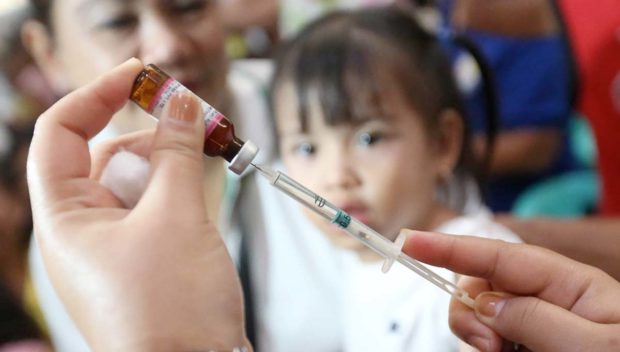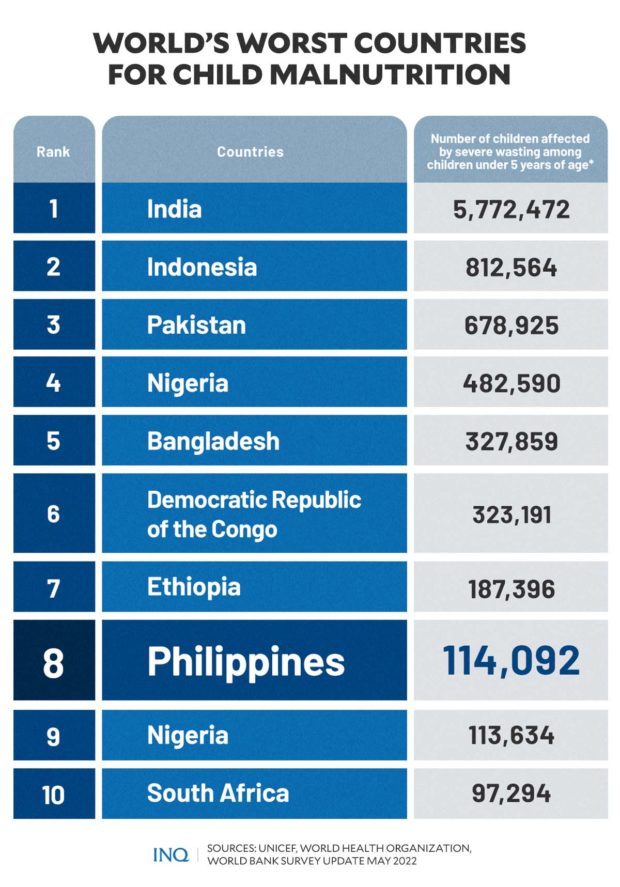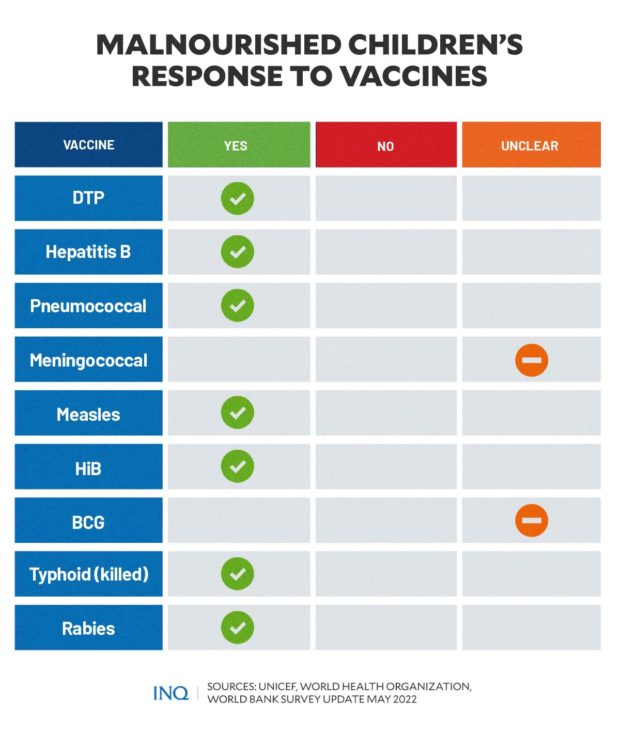As vaccination rates plummet, children face bigger monster—wasting

The Department of Health launched in Parañaque City an intensified vaccination program for children in April 2018. FILE PHOTO/MARIANNE BERMUDEZ
(Second of two parts)
MANILA, Philippines—In 2021, when the COVID-19 pandemic aggravated the biggest drop in childhood vaccination, many countries also struggled with a huge health problem that continues to jeopardize children’s survival worldwide—malnutrition.
In recently released data by World Health Organization (WHO) and UNICEF, figures showed that at least 25 million children under the age of 1 year could not receive essential vaccines last year—the highest number recorded since 2009.
The latest immunization coverage data also showed that the Philippines was among the countries with the highest number of children who did not receive a single dose of at least one of the most crucial childhood vaccines.
The decline in childhood vaccinations in 2021—which was the “largest backslide” in childhood vaccinations in approximately 30 years—was attributed to several factors, such as the increase in the number of children living in conflict and fragile settings (where immunization access is often difficult or highly risky) and increased lies on social media.
Article continues after this advertisementCOVID-related issues, including service and supply disruptions, resource diversion to response efforts, and containment measures, likewise played a considerable role in the decline as it caused limited immunization service access and availability in many countries.
Article continues after this advertisementREAD: COVID worsens ‘largest backslide’ in child vaccinations in 30 years
To make things worse, WHO and UNICEF noted that the “historic backsliding in rates of immunization” occurred amid the “rapidly rising rates of severe acute malnutrition” among children worldwide.
More malnourished children
In a report titled ‘Severe wasting: An overlooked child survival emergency,’ WHO, UNICEF, and World Bank found that at least 10 million children across the globe are severely wasted—or weigh too low for their height.
The data also showed a far grimmer picture: one in five deaths among children worldwide is attributed to severe wasting—making it one of the top threats to child survival.
“Wasting, defined as low weight-for-height, is the most visible and lethal type of malnutrition. It affects over 45 million children under age 5,” the report stated.
“Severe wasting, also known as severe acute malnutrition, is its most deadly form. It is caused by a lack of nutritious food and repeated bouts of diseases such as diarrhea, measles, and malaria, which compromise a child’s immunity,” it added.
The Philippines, according to the report, was among the countries with the highest number of children under five years of age suffering from severe wasting between 2017 and 2021, with at least 114,092 children with severe wasting.
Other countries on the list were India—the top, accounting for 5,772,472 children with severe wasting—Indonesia, Pakistan, Nigeria, Bangladesh, Democratic Republic of Congo, Ethiopia, Niger, and South Africa.
Five countries on the list—Philippines, India, Nigeria, Indonesia, and Ethiopia—were also the top low-and middle-income countries with the highest number of children who did not receive a single dose of vaccine against diphtheria, tetanus, and pertussis (DTP vaccine).
Philippine Statistics Authority (PSA) data found that 4,844 Filipino children died of malnutrition between January and October 2021. This was 37.85 percent higher than 3,514 during the same period in 2020.
Separate data by World Bank noted that even after almost three decades, there had been no improvement in the prevalence of undernutrition in the Philippines. Last year, 29 percent—or one in three—children younger than five years old suffered from stunting or being small for their age.
“The Philippines is ranked fifth among countries in the East Asia and Pacific region with the highest prevalence of stunting and is among the ten countries in the world with the highest number of stunted children,” World Bank said.
READ: Gov’t seeks private sector help in fight to end kids’ malnutrition
In 2018, PSA reported that 8.1 percent—or 3.2 million—Filipino children were food poor. One in 10 children belonged to food-poor families that same year.
According to the United Nations (UN), food poverty refers to household-level hunger.
“Households in food poverty do not have enough food to meet the energy and nutrient needs of all their members. Depending on patterns of intra-household distribution, at least one member of a food-poor household is always hungry, but, potentially, all members are.”
Impact on vaccine efficacy
According to UNICEF, severe wasting—or malnutrition—turns common childhood illnesses into killer diseases.
“Children who are severely wasted succumb to those diseases because their bodies provide virtually no protection against the bacteria, virus or fungi that infect them,” said UNICEF.
“They die because their digestive systems can no longer absorb nutrients. A severely wasted child is reduced to the most basic bodily functions. It takes all their energy just to keep breathing.”
A severely wasted child was 11 times more likely than a well-nourished child to die of common childhood illnesses such as pneumonia, the single largest infectious cause of death in children worldwide—and could be prevented through routine vaccination.
“A malnourished child already has weakened immunity, and missed vaccinations can mean common childhood illnesses quickly become lethal to them. The convergence of a hunger crisis with a growing immunization gap threatens to create the conditions for a child survival crisis,” WHO explained.
Moreover, even if there are accessible and available vaccines against common illnesses among children, scientists found that malnutrition—which can cause immunodeficiency—may impact the efficacy of vaccines for children.
“Malnourished children, therefore, stand to benefit hugely from vaccination, but malnutrition has been described as the most common immunodeficiency globally, suggesting that they may not be able to respond effectively to vaccines,” a 2015 study stated.
READ: https://royalsocietypublishing.org/doi/pdf/10.1098/rstb.2014.0141
However, the study clarified that there were limited data on the matter. Still, it discovered that malnourished children “can generally produce a protective response from a variety of vaccines, although their immune response is sometimes lower than that of well-nourished children.”
While malnourished children responded well to certain vaccines (DTP, Hepatitis B, Pneumococcal, Measles, HiB, Typhoid, Rabies), it was still unclear whether BCG and conjugate meningococcal vaccines would be effective.
Immunization Agenda 2030
To improve the current situation on childhood vaccination, WHO and UNICEF are currently working with Gavi, The Vaccine Alliance, and other partners to deliver the Immunization Agenda 2030 (IA2030).
The IA2030 is a strategy for all countries and relevant global partners to achieve goals of preventing diseases through vaccination and delivering vaccines to everyone, everywhere, and for every age.
“It’s heartbreaking to see more children losing out on protection from preventable diseases for a second year in a row,” said Dr. Seth Berkley, CEO of Gavi, The Vaccine Alliance.
“The priority of the Alliance must be to help countries to maintain, restore and strengthen routine immunization alongside executing ambitious COVID-19 vaccination plans, not just through vaccines but also tailored structural support for the health systems that will administer them,” Berkley added.
The IA2030 partners, WHO said, call on governments and relevant actors to:
- Intensify efforts for catch-up vaccination to address the decline in routine immunization, and expand outreach services in underserved areas to reach missed children and implement campaigns to prevent outbreaks;
- Implement evidence-based, people-centered, and tailored strategies to build trust in vaccines and immunization, fight misinformation, and increase vaccine uptake, especially among vulnerable countries;
- “Ensure current pandemic preparedness and response and the global health architecture strengthening efforts lead to investment in primary health care (PHC) services, with explicit support to strengthen and sustain essential immunization”
- Ensure commitment from national governments and increase domestic resource allocation to strengthen and sustain immunization with PHC;
- “Prioritize health information and disease surveillance systems strengthening to provide the data and monitoring needed for programs to have maximum impact”
- “Leverage and increase investment in research to develop and improve new and existing vaccines and immunization services that can achieve community needs and deliver on IA2030 goals.”
Last April, the DOH, in partnership with WHO and UNICEF, launched an annual vaccination drive that aims to reach at least one million children who have missed out and yet to receive any routine vaccine.
“We want to replicate the success of the COVID-19 National Vaccination Drives (NVDs) for routine childhood vaccinations,” said then Health Secretary Francisco Duque III.
“This is to help improve immunization coverage among the pediatric population. With the help of our stakeholders, we can ensure that vaccines are available, sufficient, and accessible to our local health facilities and communities. Together, we shall stop not only COVID-19 but also other potential vaccine-preventable diseases and outbreaks,” Duque had said.
WHO and UNICEF pledged to support the drive by providing resources in vaccine management, research, and planning at a regional and national level as a step in preventing outbreaks in countries with an alarming decline in vaccination coverage.
“To reach every child with life-saving vaccines, we need investments in planning and monitoring, human resources, and targeted support for LGUs that are lagging behind,” said Oyunsaikhan Dendevnorov, UNICEF representative.
“We stand together to make Chikiting Bakunation Days a success for children, and we commend the DOH for the initiative in taking the action in protecting the children,” Dendevnorov said.
“Vaccines bring us closer to a world where future generations are protected from disease outbreaks and epidemics,” said Dr. Rajendra Yadava, acting WHO representative to the Philippines.
“We are making vital progress against today’s biggest health challenges, but we must ensure everyone, everywhere, can benefit. Vaccines give everyone the opportunity to reach their full potential and pursue a life well-lived,” Yadav said.
TSB

